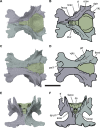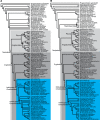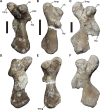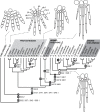Anatomy of Rhinochelys pulchriceps (Protostegidae) and marine adaptation during the early evolution of chelonioids
- PMID: 31106054
- PMCID: PMC6500378
- DOI: 10.7717/peerj.6811
Anatomy of Rhinochelys pulchriceps (Protostegidae) and marine adaptation during the early evolution of chelonioids
Abstract
Knowledge of the early evolution of sea turtles (Chelonioidea) has been limited by conflicting phylogenetic hypotheses resulting from sparse taxon sampling and a superficial understanding of the morphology of key taxa. This limits our understanding of evolutionary adaptation to marine life in turtles, and in amniotes more broadly. One problematic group are the protostegids, Early-Late Cretaceous marine turtles that have been hypothesised to be either stem-cryptodires, stem-chelonioids, or crown-chelonioids. Different phylogenetic hypotheses for protostegids suggest different answers to key questions, including (1) the number of transitions to marine life in turtles, (2) the age of the chelonioid crown-group, and (3) patterns of skeletal evolution during marine adaptation. We present a detailed anatomical study of one of the earliest protostegids, Rhinochelys pulchriceps from the early Late Cretaceous of Europe, using high-resolution μCT. We synonymise all previously named European species and document the variation seen among them. A phylogeny of turtles with increased chelonioid taxon sampling and revised postcranial characters is provided, recovering protostegids as stem-chelonioids. Our results imply a mid Early Cretaceous origin of total-group chelonioids and an early Late Cretaceous age for crown-chelonioids, which may inform molecular clock analyses in future. Specialisations of the chelonioid flipper evolved in a stepwise-fashion, with innovations clustered into pulses at the origin of total-group chelonioids, and subsequently among dermochelyids, crown-cheloniids, and gigantic protostegids from the Late Cretaceous.
Keywords: Chelonioidea; Flipper evolution; Intraspecific variation; Marine adaptation; Neuroanatomy; Phylogeny; Protostegidae; Taxonomy.
Conflict of interest statement
The authors declare that they have no competing interests.
Figures
























Similar articles
-
New insights into the early morphological evolution of sea turtles by re-investigation of Nichollsemys baieri, a three-dimensionally preserved fossil stem chelonioid from the Campanian of Alberta, Canada.Swiss J Palaeontol. 2024;143(1):27. doi: 10.1186/s13358-024-00323-8. Epub 2024 Jul 12. Swiss J Palaeontol. 2024. PMID: 39006951 Free PMC article.
-
Rhinochelys amaberti Moret (1935), a protostegid turtle from the Early Cretaceous of France.PeerJ. 2018 Apr 10;6:e4594. doi: 10.7717/peerj.4594. eCollection 2018. PeerJ. 2018. PMID: 29666758 Free PMC article.
-
Comparative cranial morphology of the Late Cretaceous protostegid sea turtle Desmatochelys lowii.PeerJ. 2018 Dec 7;6:e5964. doi: 10.7717/peerj.5964. eCollection 2018. PeerJ. 2018. PMID: 30568851 Free PMC article.
-
The Paleogene fossil record of birds in Europe.Biol Rev Camb Philos Soc. 2005 Nov;80(4):515-42. doi: 10.1017/S1464793105006779. Biol Rev Camb Philos Soc. 2005. PMID: 16221327 Review.
-
The evolutionary position of turtles revised.Naturwissenschaften. 2001 May;88(5):193-200. doi: 10.1007/s001140100228. Naturwissenschaften. 2001. PMID: 11482432 Review.
Cited by
-
The Making of Calibration Sausage Exemplified by Recalibrating the Transcriptomic Timetree of Jawed Vertebrates.Front Genet. 2021 May 12;12:521693. doi: 10.3389/fgene.2021.521693. eCollection 2021. Front Genet. 2021. PMID: 34054911 Free PMC article.
-
Turtle body size evolution is determined by lineage-specific specializations rather than global trends.Ecol Evol. 2023 Jun 26;13(6):e10201. doi: 10.1002/ece3.10201. eCollection 2023 Jun. Ecol Evol. 2023. PMID: 37384241 Free PMC article.
-
Digital skull anatomy of the Oligocene North American tortoise Stylemys nebrascensis with taxonomic comments on the species and comparisons with extant testudinids of the Gopherus-Manouria clade.Swiss J Palaeontol. 2024;143(1):12. doi: 10.1186/s13358-024-00311-y. Epub 2024 Mar 5. Swiss J Palaeontol. 2024. PMID: 38455968 Free PMC article.
-
Comparative analysis of the shape and size of the middle ear cavity of turtles reveals no correlation with habitat ecology.J Anat. 2019 Dec;235(6):1078-1097. doi: 10.1111/joa.13071. Epub 2019 Aug 2. J Anat. 2019. PMID: 31373396 Free PMC article.
-
Shell Constraints on Evolutionary Body Size-Limb Size Allometry Can Explain Morphological Conservatism in the Turtle Body Plan.Ecol Evol. 2024 Nov 12;14(11):e70504. doi: 10.1002/ece3.70504. eCollection 2024 Nov. Ecol Evol. 2024. PMID: 39539674 Free PMC article.
References
-
- Ali F, Zelenitzky DK, Therrien R, Weishampel D. Homology of the “ethmoid complex” of tyrannosaurids and its implications for the reconstruction of the olfactory apparatus of non-avian theropods. Journal of Vertebrate Paleontology. 2008;28(1):123–133. doi: 10.1671/0272-4634(2008)28[123:HOTECO]2.0.CO;2. - DOI
-
- Anquetin J. Reassessment of the phylogenetic interrelationships of basal turtles (Testudinata) Journal of Systematic Palaeontology. 2012;10(1):3–45. doi: 10.1080/14772019.2011.558928. - DOI
-
- Anquetin J, Püntener C, Joyce WG. A review of the fossil record of Turtles of the Clade Thalassochelydia. Bulletin of the Peabody Museum of Natural History. 2017;58(2):317–369. doi: 10.3374/014.058.0205. - DOI
LinkOut - more resources
Full Text Sources

